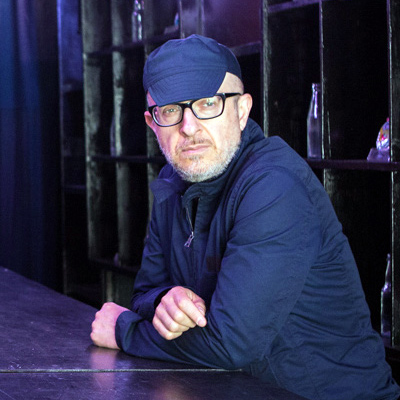
Flavio Favelli
Hic et Nunc, 2019
Hic et Nunc is a special environment greeting visitors as they enter Arte Fiera. An ‘inhabitable sculpture’, Hic et Nunc – like all Favelli’s work - triggers surprise for its combination of functionality and aesthetics, its domestic yet public character, and the reference to both past and present.
“After the series 'Sala d’Attesa', 'Hic et Nunc' is an attempt to create a place rather than a mere space. Short-lived like its art fair setting, it is a deliberately enigmatic place, more like a museum area displaying large artworks. The artworks create partitions with seating, allowing people to stop awhile and admire the sculptures. Outside on the corners of the outer walls are two luminous signs: NUNC, and an old clock - found in a jeweller’s shop – that might well have once been on the façade of a railway station. The first – NUNC – was created from the original neon sign of the famous Italian record shop, Nannucci. I have attempted to create a specific place in a standard setting like that of a fair, whose hallmarks are the constant ephemeral flow of people, scant landmarks, and vast covered areas designed to contain anything.
The new environment Hic et Nunc attempts to stop time and space in an environment that is the epitome of impermanence, where the shortened day passes by swiftly, marked out by consolidated rituals.” (Flavio Favelli)
The artist would like to thank Officine Chigiotti (Grosseto) for the hospitality given to the work Mobilia Essay (2015), which has been included - in a revised form - in Hic et Nunc.
Besides Hic et Nunc, another public work by Favelli will be inaugurated in Bologna during the days of Arte Fiera: Purple Tosca, an installation created for the Rotonda Gluck in Bologna’s Teatro Comunale, developed within the framework of the partnership between the art fair and the city’s opera house; Teatro Comunale will open to the public on Saturday 2 February, from 4 to 7 pm.
Born in Florence in 1967, Flavio Favelli lives and works in Savigno (Bologna).
After graduating in Oriental History at Bologna University, he took part in the Link Project (1995-2001).
Favelli has exhibited in public and private venues both in Italy and abroad, as well as in museums such as Rome’s MACRO and MAXXI, the MAMbo in Bologna, Florence’s Marino Marini, RISO in Palermo, the Pecci Art Centre in Prato, Turin’s Sandretto Re Rebaudengo Foundation, Maison Rouge and the Antoine de Galbert Foundation in Paris, Projectspace 176 in London, the Venice Peggy Guggenheim Collection, Bergamo’s GAMEC, Maison Particulière in Brussels, Turin’s Castello di Rivoli and GAM, the 11th Havana Biennial, the No Soul For Sale Festival at London’s Tate Modern, the Pomodoro Foundation in Milano, the MADRE Museum and PAN in Naples, Shanghai’s MOCA, Villa delle Rose GAM in Bologna, the Modern Art Museum of Saint-Etienne, the Museion in Bolzano ,and Istanbul’s Elgiz Museum.
Favelli took part in the 13th Carrara Sculpture Biennial, the 15th Rome Quadriennale at the Palazzo delle Esposizioni, and in the exhibition "Italics" at Palazzo Grassi, Venice, which subsequently went on to Chicago’s MCA.
He has designed and installed two permanent public environments: Vestibolo in the Venice headquarters of ANAS in Palazzetto Foscari, and Sala d'Attesa in the Pantheon, set aside for secular funeral ceremonies in Bologna’s Certosa Cemetery. In 2015, his Gli Angeli degli Eroi was chosen by the Quirinale, the home of the Italian President, to commemorate fallen soldiers to whom ceremonies are dedicated every 4 November.
Favelli was part of two Venice Biennales: the 50th (“Clandestini”, curated by F. Bonami) and the 55th ("Vice versa", Italy Pavilion, curated by B. Pietromarchi).
In 2016, he was invited to give a keynote address on contemporary art to mark the beginning of the academic year at Pisa’s prestigious Scuola Normale Superiore. In 2017, his project Serie Imperiale won the second edition of Italian Council competition.
